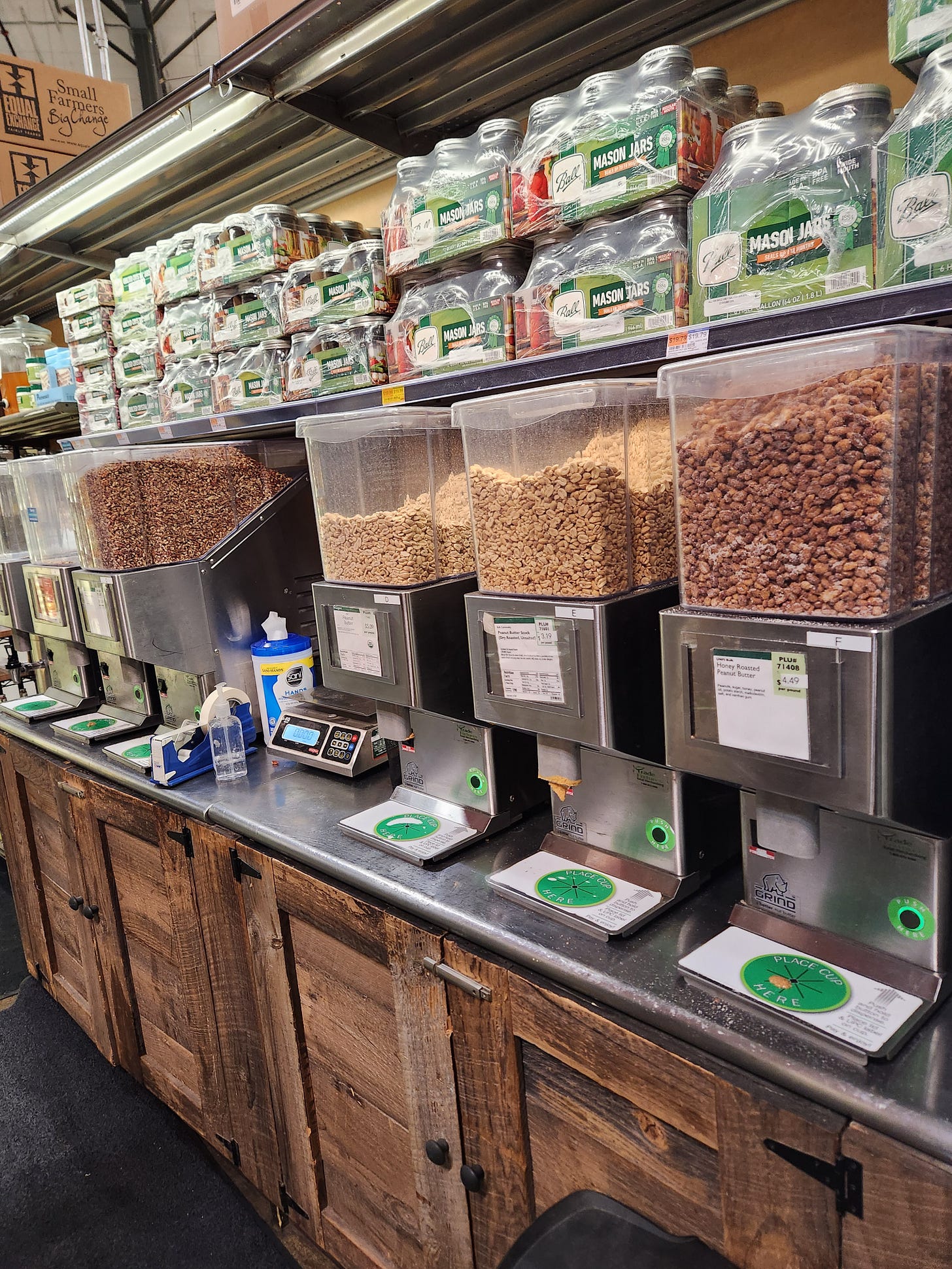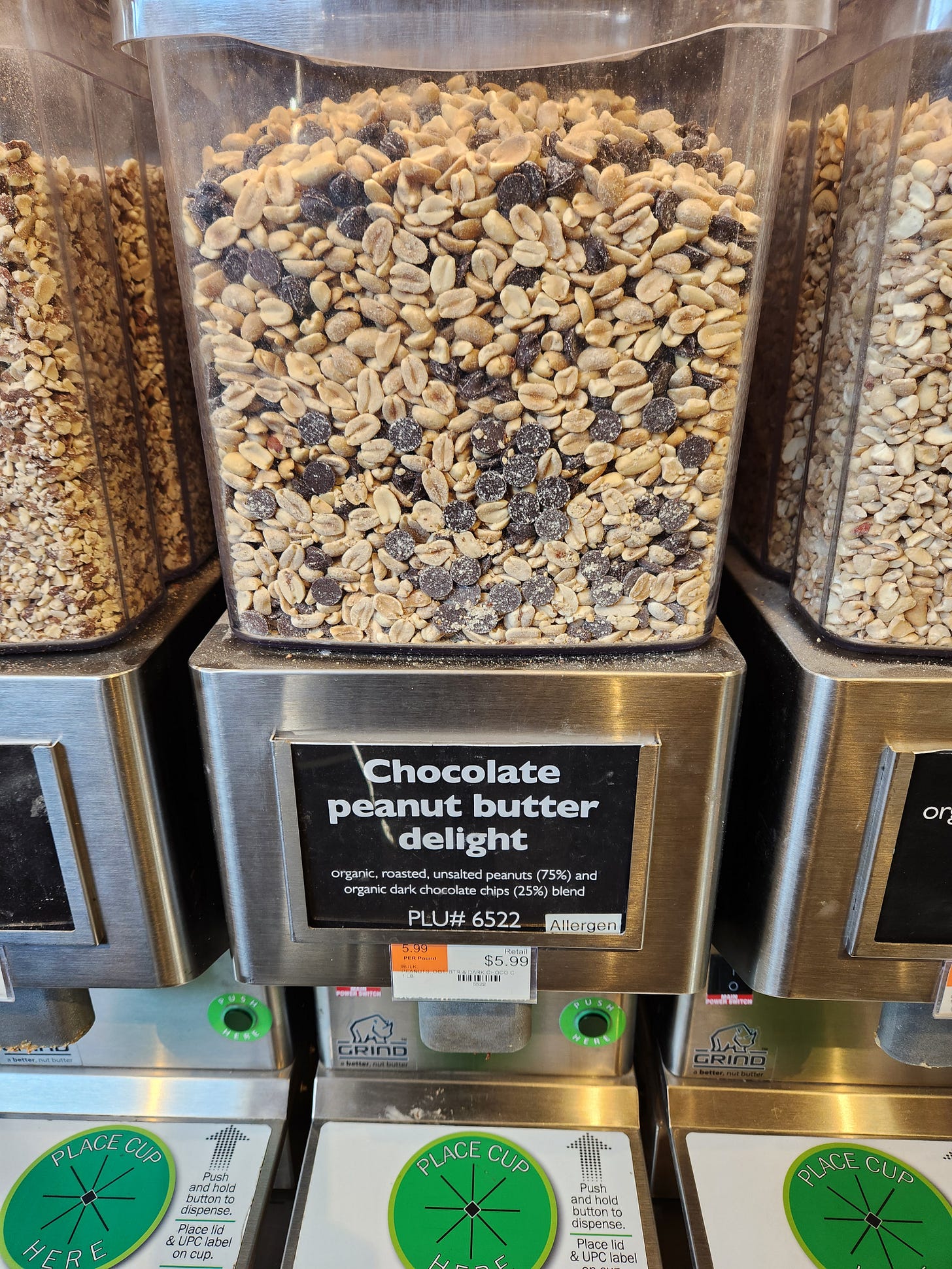Over the past few weeks, Mauricio and I have been doing some spring foodie traveling, and we’ve ended up at a few of the Northeast’s numerous food co-ops. Of all the foods we ate, one excited me more than any other: freshly ground peanut butter. We’ve been New Yorkers for over a year now, and I know that’s not very long compared to some people, but it is long enough to have been to many grocery stores, bodegas, co-ops, and shops. I think in our year of research, we may have found the one thing that does not exist in the city that has everything, and I think it may be freshly ground peanut butter. (If we’re wrong about this, please let us know in the comments. We’re already halfway through our vacation supply and need more!)
How do you know that freshly ground peanut butter really is fresh? Simple. You grind it yourself. The peanuts sit in a large machine, and all you have to do is put an empty container below the machine to catch the delicious peanut butter and then flip up the on switch. If you’ve never eaten freshly ground peanut butter, all I can say is that it is unlike any other peanut butter out there. All other peanut butter is a lie.
At the intersectionality of food and machines, the topic of self-sufficiency can be a bit complicated. Ever since the Industrial Revolution introduced machines into our daily lives, we’ve come to depend on them. We use machines for everything now, from electric toothbrushes to cell phones to dishwashers. But when contemplating which machines we want to own and use in our daily lives, there are two conflicting facts at play: they both help us achieve self-sufficiency, and they make us reliant on the infrastructure required to keep them operable.
As bakers, we think about machinery a lot. Grains follow a standard trajectory to make it from the field to a loaf a bread, and several key machines serve vital roles along the way. While these shiny pieces of equipment save us humans from hours of backbreaking work, they’re bottlenecks in the system that are costly to purchase, run, and maintain. In industries such as the food industry that operate on tight margins with no room for financial bad luck, depending on an expensive machine can be a source of anxiety and stress. A single machine breaking down can seal the fate of many food businesses, and if that machine is the walk-in cooler, the failure smells extra bad.
But, machine ownership wasn’t always so individualistic. Before roller-milled flour and home ovens became the norm, many towns were built around shared stone mills and bread ovens. The townsfolk would bring their grain to the mill to have it ground into flour, and they would bring their bread doughs to be baked with all the others in the large community oven. While planning around the town miller’s or baker’s schedule was surely a hassle, having access to the finest equipment available without needing to purchase it, operate it, or maintain it was surely a net benefit for the townsfolk. And, if the mill or oven ever broke down, many people with vested interests were able to lend physical and financial support to get it running again.
These days, machines are marketed to individuals, not communities. We’re constantly being tempted to buy the new car model, but do we ever see tv ads for a new bus that could serve the whole community? The assumption is that we need to own every machine we intend to benefit from, even if it’s something like an inflatable mattress pump or an automated Halloween candy bowl we’ll only use once a year. Machines are expensive, and it’s easy to get caught up in the cycle of buying the cheapest versions available and then needing to replace them constantly. This is a drain on our wallets and a major cause of pollution for our planet.
But, there are some groups who are actively challenging the one-machine-per-household mentality. Tool libraries are gaining popularity in many towns. Just like any other library, they allow residents to rent items for a day or longer, except instead of renting books or movies, users rent pieces of equipment. The Brooklyn Public Library rents everything from hammers to hot glue guns to extension cords.
In the grain community, farmers, millers, and bakers are coordinating sharing equipment too. One of our baker friends from Virginia recently told us about how she and another baker are teaming up to purchase whole wheat berries from one farm and run them through a gravity table at another. A gravity table is a special piece of equipment that cleans out the natural debris like sticks and stones which are accidentally mixed with the wheat berries during the harvest. Gravity tables can cost upwards of thirty thousand dollars, a prohibitively high price for many small farmers. But by combining forces and doing a bit of planning, grain industry folks can make sure everyone is included in the supply chain.
In our Substack, we talk a lot about tabletop stone mills. If this is a piece of equipment that you’d like to have access to but don’t necessarily want to purchase just for your own occasional use, consider asking your neighbors and community members if they’d be interested in chipping in for a shared use mill. Perhaps it could live in your neighborhood’s community room or your church’s kitchen.
Sharing equipment allows us to increase our access to the very tools that make us as individuals self-sufficient and our communities resilient. Sharing also distributes the costs in a way which enables the purchase of higher quality machines which will last longer, benefitting the initial investors and keeping our landfills a bit cleaner. Next time you grind your own nut butter or mill your own flour on a shared machine, do it with a spirit of cooperation, knowing you’re strengthening your community with your actions. The fact that the food you’re preparing will be the freshest, most delicious version out there, doesn’t hurt either.
This week’s recipe is for Nut Butter Brownies, a delicious use for freshly ground nut butter of any type: peanut, almond, hazelnut, or even pistachio. As someone who generally refrains from buying commercial, or homogenized, nut butters, it’s always bugged me that most nutty recipes require the purchase of a commercial nut butter product just for baking. This recipe doesn’t. If you’re lucky enough to have access to a nut butter machine at your local grocery store or food co-op, you know that quality just can’t be beat. If not, we include instructions on how to make your own nut butter at home using a food processor. Let’s get baking!






